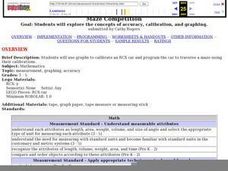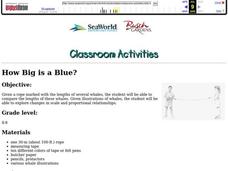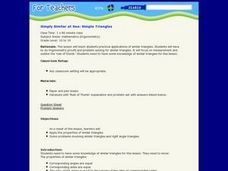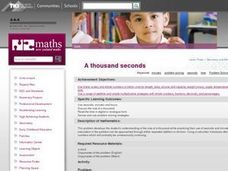Curated OER
Car Maze competition
Pupils use graphs to calibrate an RCX car. They must then program the car to traverse a maze using their calibrations
Curated OER
Tomb Explorer/Temple Explorer
Fourth graders build an explorer vehicle which they program through an obstacle course to enter the tomb or temple to discover artifacts.
Curated OER
The Home Stretch
Students read the novel Stone Fox by John Reynold Gardiner. Using Lego RCX units, students build and program sleds to re-enact the "home stretch" of the National Dog Sled Race.
Curated OER
Let the North Star Tell You Where You Are
Young scholars create an astrolabe and locate the North Star in the night sky. They determine the latitude of the North Star, and calculate an average latitude based on class results.
Curated OER
HOW BIG IS A BLUE?
Students compare the lengths of whales using different lengths of rope. They illustrate one whale in life-size proportion.
Curated OER
The Gingerbread Man
In this unit students use the traditional tale of the gingerbread man as a context for ordering and comparing lengths. They compare the length of two objects directly, order three or more objects by length and select objects that are...
Curated OER
Area of irregular Polygons: Historical Motivator - Lewis and Clark Adventure
Seventh graders find the area of irregular polygons. In this lesson on calculating area, 7th graders use the adventures of Lewis and Clark as motivation to learn how to calculate the area of irregular polygons.
Curated OER
This Building is Tall
Young scholars calculate the perimeter of shapes. In this geometry lesson, students relate properties of polygons to the real world. They find length, midpoint and slope.
Curated OER
Quiz: Astronomy
In this science worksheet, 3rd graders will focus on various aspects of astronomy. Students will respond to ten questions all pertaining to stars, constellations, planets, and our solar system.
Curated OER
Christmas Presents
Seventh graders create a graph of their Christmas gifts. They develop categories, compute fractional and decimal parts for each category, identify the number of degrees to represent each fractional part, and create a circle graph to...
Curated OER
Algebra 2/Trigonometry Regents Exam
Students review for the Regents Exam. In this math lesson, students review core concept for the Regents exam by working a variety of problems. A printable worksheet is provided.
Curated OER
Wings and Othe Things
Students work in groups that are engaged in different activities at different times. They watch the video "Madagascar" and collect data pertaining to the Fish Eagle's arm spam. They work together to perform mathematical computations...
Curated OER
Simply Similar at Sea: Simple Triangles
Tenth graders answer a variety of problems based on similar triangle and learn about the rule of thumb. They will test the rule of thumb by estimating the distance to an object in the classroom.
Curated OER
Parallax
Students discover how astronomers used the diameter of the Earth's orbit around the Sun as a baseline for estimating the distance of some stars, and the meaning of "Parsec" and "light year."
Curated OER
Time Flies When Math Is Fun
Third graders pracdtice telling time with a demonstration clock.
Curated OER
Rice (Gohan) Observations
Second graders investigate rice or gohan as it's called in Japan in a couple of experiments. They tally the results.
Curated OER
A thousand seconds
Students use seconds, minutes, and hours. They then discuss the size of a thousand. After that they read time in digital or analogue form.


















